Photo

Photo

cunnilingusbliss: dessert is served

dessert is served
#legalizeit

#legalizeit
#funny

#funny
Photo

pervyblack: If this ain't photoshopped, I am truly impressed. ...

If this ain't photoshopped, I am truly impressed. What a stunning waistline and hips
#NWO

#NWO
Photo

#repost

#repost
Photo

sciencesoup: Waitomo Glowworm Caves For over one hundred years,...
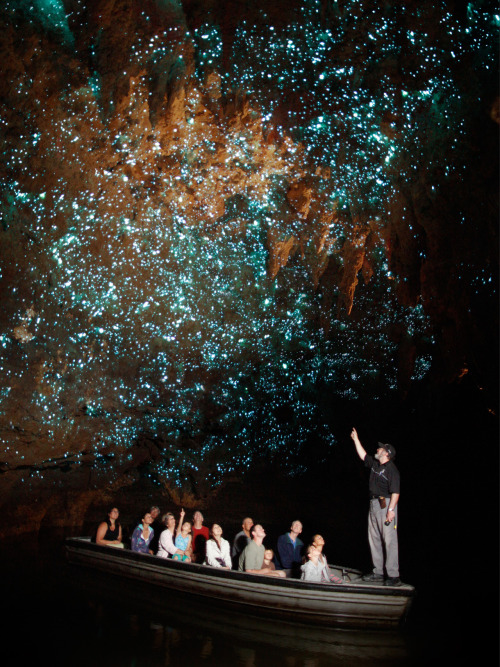
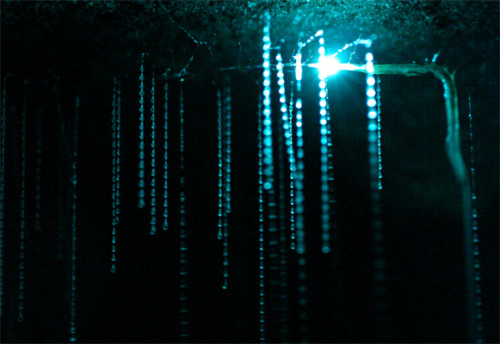
Waitomo Glowworm Caves
For over one hundred years, millions of tourists have flocked to the ancient limestone Waitomo Caves on New Zealand's North Island, where stunning species of fungus gnat called Arachnocampa luminosa live. The genus is unique to New Zealand and Australia, and they are found in caves, grottoes, and other sheltered places. Arachnocampa means 'spider-worm,' as the gnat is known for the way their larvae hang strong vertical silk threads from the ceilings of their underground habitats. The threads are from one to fifty centimetres long and are studded with evenly spaced drops of sticky mucus, acting like fishing lines to lure in prey. Since the larvae are luminescent, the thousands of tiny threads light up cave ceilings like a starry sky. Other insects are attracted to the light and fly up—but then become ensnared in the sticky mucus, which contains proteins that researchers think may act as an anaesthetic. The larvae live this way for many months, trapping and devouring their prey, before becoming a shot-lived adult gnat.
sciencesoup: Transparent-Headed Fish First described in 1939,...

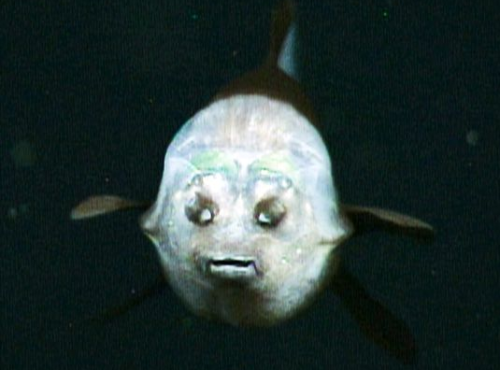

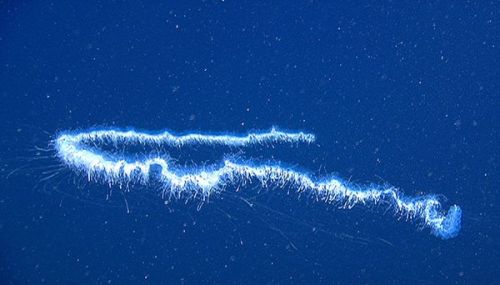
Transparent-Headed Fish
First described in 1939, the unusual Pacific barreleye (Macropinna microstoma) is instantly recognisable by the transparent, fluid-filled dome that curves over its head like the cockpit of a fighter jet. The two green spheres within are actually the fish's tubular eyes, while the dark capsules in front are the fish's olfactory organs, responsible for smell. The barreleye lives in inky depths of over 600 metres, where sunlight fades to darkness, and its eyes have adapted remarkably. They're so sensitive that they can detect faint silhouettes of prey passing overhead, and their green pigments are thought to filter out sunlight, allowing the barreleye to focus on its preys' bioluminescent glow. It's long been thought that these eyes are fixed, so the fish only has a tunnel-vision view of whatever is above its head, but researchers at the Monterey Bay Aquarium Research Institute have shown that the eyes can rotate around 75 degrees, from a vertical to a horizontal position. Along with its large flat fins, this amazing vision allows the 15 cm fish maneuver precisely and capture prey with its small pointed mouth. Interestingly, the barreleye shares its deep-sea habitat with many kinds of jellies, including the siphonophore, which grows to over 10 metres and trails out thousands of stinging tentacles like drift nets to capture prey. Researchers think that one of the barreleye's feeding methods is to carefully manoeuvre among the siphonophore's tentacles to steal its prey, and the transparent dome shields the fish's eyes from the stinging tentacles.
sciencesoup: Photons and Relativity Photons are elementary...

Photons and Relativity
Photons are elementary particles that carry the electromagnetic force, including light, and they're much cooler than many give them credit for. It's common knowledge that photons travel at the speed of light—the universe's maximum speed—so the light we see from distant stars and galaxies is ancient, sometimes taking billions of years to reach us. But amazingly, photons don't actually experience this time. Relativity tells us that as an object approaches the speed of light, it experiences two things: increased mass, and time dilation (i.e., time slows down). Because photons are massless, they are the only things able to reach the speed of light, and at that speed, time dilation is infinite, which means that time effectively stops for them. From their point of view, photons are emitted and reabsorbed instantaneously. This holds true for a photon emitted in the Sun that is reabsorbed a fraction of a millisecond later, and is equally true for a photon emitted in a distant star that travels for 13 billion years before it's reabsorbed by your eye. Either way, photons think they arrive instantaneously. Futhermore, time and space are just two aspects of the same thing—spacetime—and so photons don't experience distance either. From their perspective, the time and location of their emission are exactly the same as the time and location of their absorption—which is mind-bending, but incredibly awesome.
sciencesoup: Free Fall through the Earth In the late 17th...

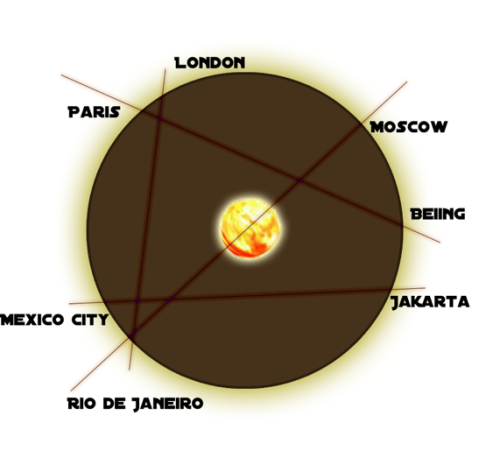
Free Fall through the Earth
In the late 17th century, British scientist Robert Hooke wrote to Isaac Newton and discussed the mathematics of a thought experiment—one where an object was dropped down a tunnel drilled through the earth. He was fascinated by the physics of it: For the first half of the journey, gravity would pull the object into free fall. It would accelerate until it reached the midway point, where it would decelerate because it would be climbing away from the centre of the earth—and yet in a completely frictionless environment, it would have exactly enough inertia to reach the opposite end of the tunnel before it stopped completely. If the earth was a perfect sphere and the tunnel was frictionless, the trip would always take exactly 42 minutes and 12 seconds no matter at what angle the tunnel was drilled. Of course, this perfect scenario doesn't exist in the real world, but the thought experiment still presents a dazzling engineering prospect—an incredibly fast transportation system (say, a train). Building this "Gravity Train" was first proposed in the 1800s, but the Paris Academy of Sciences wisely declined the ambitious plan—and even now, the concept is seemingly out of reach. Billions of cubic metres of rock would have to be hauled away to even drill the tunnels, the extreme heat and pressure of the core and mantle would present a huge problem, and measures would have to be taken to minimise friction. Transporting cargo between continents seems like a more feasible outcome than transporting humans, but we can hope that some incarnation of this Gravity Train will come into the realms of possibility before another four hundred years has passed.
sciencesoup: Argentavis magnificens: Magnificent Argentine...
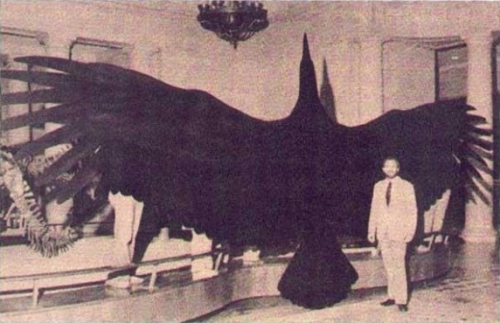
Argentavis magnificens: Magnificent Argentine Bird
With a wingspan of nearly 7 metres, Argentavis magnificens is the largest known bird to ever fly. It lived 6 million years ago in the open plains of Argentina and the Andes mountains, and it is related to modern-day vultures and storks—but with feathers the size of Samurai swords. It rivals some light aeroplanes in size, but it is believed to have flown on the wind more like a glider, soaring to speeds of 240 km/h. But with its massive flight muscles and enormous wings, the behemoth bird weighed 70 kilograms, so flapping its wings was not enough to achieve lift-off. "Birds are commonly compared with aircraft, but in reality helicopters are a better analogy," says Sankar Chatterjee of Texas Tech University. Chatterjee and his team came to understand the bird's flight by collaborating with a retired aeronautical engineer, inputting measurements from fossils into a computer program designed to study flight performance in helicopters. They determined that Argentavis must have run downhill into a headwind in order to become airborne, just like hang gliders, then gained elevation by circling inside columns of air known as "thermal elevators." It would have easily hitched a ride a few kilometres up without even flapping its wings—then by just gliding to adjoining thermals, it would have been able to travel hundreds of kilometres per day.
sciencesoup: Argentavis magnificens: Magnificent Argentine...

Argentavis magnificens: Magnificent Argentine Bird
With a wingspan of nearly 7 metres, Argentavis magnificens is the largest known bird to ever fly. It lived 6 million years ago in the open plains of Argentina and the Andes mountains, and it is related to modern-day vultures and storks—but with feathers the size of Samurai swords. It rivals some light aeroplanes in size, but it is believed to have flown on the wind more like a glider, soaring to speeds of 240 km/h. But with its massive flight muscles and enormous wings, the behemoth bird weighed 70 kilograms, so flapping its wings was not enough to achieve lift-off. "Birds are commonly compared with aircraft, but in reality helicopters are a better analogy," says Sankar Chatterjee of Texas Tech University. Chatterjee and his team came to understand the bird's flight by collaborating with a retired aeronautical engineer, inputting measurements from fossils into a computer program designed to study flight performance in helicopters. They determined that Argentavis must have run downhill into a headwind in order to become airborne, just like hang gliders, then gained elevation by circling inside columns of air known as "thermal elevators." It would have easily hitched a ride a few kilometres up without even flapping its wings—then by just gliding to adjoining thermals, it would have been able to travel hundreds of kilometres per day.
sciencesoup: The Scaly Anteater With eight different species...



The Scaly Anteater
With eight different species found across Asia and sub-Saharan Africa, pangolins or "scaly anteaters" are nocturnal, solitary, and often quite secretive creatures. All species share the characteristic of thick, armour-like scales, but despite their scaly appearance they are actually mammals, and their scales are made from keratin—the same protein that forms human hair and fingernails. These scales make up 20% of their bodyweight and are able to cut anything inserted between them, so the pangolin's first line of defence is to roll up into a tight ball. Their diet is mainly composed of ants and termites, and because they have poor eyesight, they use their strong sense of smell to locate nests and reach into them with their amazingly long and sticky tongues. In some places, pangolins are thought to be purveyors of magic and charms—the scales are thought to neutralise evil spirits, keep predators away or call down rains—but this poaching, along with trafficking and habitat loss, is posing a serious threat to these weird but wonderful creatures. Several species are listed as endangered, and several more as threatened. Want to help?
sciencesoup: The Illusion of Separation "A human being is a...

The Illusion of Separation
"A human being is a part of the whole called by us 'the universe,' a part limited in time and space," wrote Einstein in 1950. "He experiences himself, his thoughts and feelings, as something separate from the rest—a kind of optical illusion of consciousness." It's a brilliant and fascinating perspective, and science tells us that it's true. Our eyes inform us that there is a definite boundary between us and the world around us, and so we perceive ourselves as entities separate to the wider universe—as individuals just making our home in this vast place. But when we take a step back, we can see that we're molecular machines built from a specific arrangements of atoms—atoms that existed before we were born and will continue to exist after we die. They were recycled from the dust of dead stars, and we're only their temporary custodians. Fundamentally, each of us is just a tiny individual expression of an enormous singular entity—so we are the universe perceiving and studying itself. The idea that the individual and the universe are inseparable is a humbling, counter-intuitive and ultimately awe-inspiring idea—there's a mad kind of beauty in knowing that we do not live in the universe, but rather we are the universe. As Feynman wrote: "I…a universe of atoms…an atom in the universe."
sciencesoup: tachypomp: sciencesoup: Graphene: The Miracle...

Graphene: The Miracle Material
Graphene is 200 time stronger than steel, harder than diamond, super flexible, and an excellent conductor of heat and electricity—and yet is only one atom thick. It's a material made out of a single layer of pure carbon atoms, arranged in a honeycomb lattice connected by the strongest bonds known to science. Basically, graphene is just a super-thin sheet of graphite, the material found in pencils—so thin that a stack of three million sheets would be just 1 mm thick. Physicists Andre Geim and Konstantin Novoselov discovered it in 2004, and later received a Nobel Prize for their work because graphene is an incredibly versatile material—comparable to the vast range of uses that plastic has—and can even be modified to take on different properties: researchers have successfully made it magnetic. Graphene's amazing mechanical, electrical and optical properties mean that it could be used for vast range of applications, from stronger and lighter car and airplane parts, to super-tough textiles, to healthcare, to a replacement for silicon in nano-electronics—which could lead to faster, thinner and more flexible electronic devices. It may be some years before we see these applications fully realised because there are still obstacles to overcome, but there's no doubt that graphene has incredible and unparalleled potential.
Fun fact: There is a poster about graphene in my physics teacher's classroom, I sit on the exact opposite side of the classroom from it so I haven't read it yet but it features a cat, so I'm going to go ahead and assume that you can use it to support cats.
YOU CAN. Geim and Novoselov calculated that a hammock made of one square metre of graphene could support a 4 kg cat—but it would only weigh as much as a single cat whisker, and it would be almost completely invisible.
Another fun fact: Geim won an Ig Nobel Prize for his work on magnetically levitatating frogs. He's actually the first person to win both an Ig Nobel and a Nobel Prize!














No comments:
Post a Comment